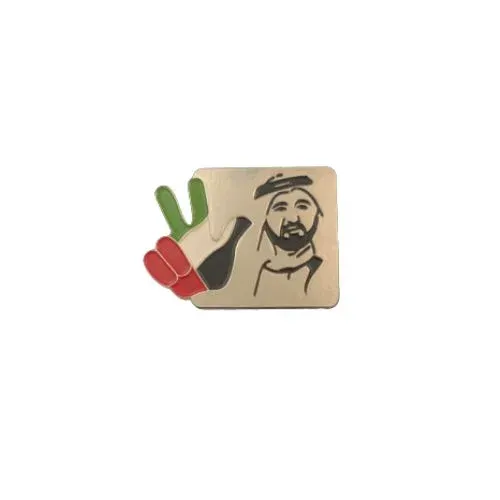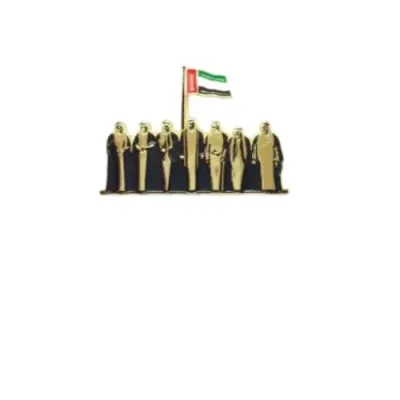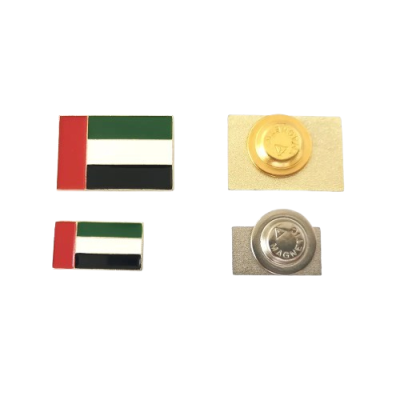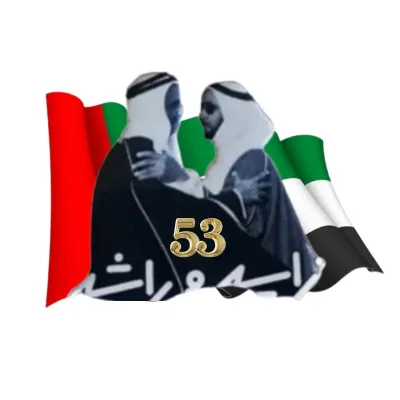The Sheikh Muhammad UAE National Day Badge with UAE Flag Victory Sign in Black is a commemorative emblem symbolizing national pride and unity. Featuring the name of Sheikh Muhammad, the UAE flag, and a black victory sign, this badge celebrates the UAE’s leadership, resilience, and triumph. It is crafted with precision to honor the UAE's National Day and reflects the country’s spirit of strength and success.
Select the color
Select Variant
Select quantity
Sheikh Muhammad UAE National Day Badge with UAE Flag Victory Sign in Black
Introduction
The Sheikh Muhammad UAE National Day Badge with UAE Flag Victory Sign in Black is more than just a decorative emblem. It embodies the spirit of the UAE’s National Day, the leadership of Sheikh Muhammad, and the unity of the nation, all while paying homage to the symbol of victory. This badge, featuring Sheikh Muhammad’s name and the UAE flag with the well-recognized victory sign, serves as a powerful reminder of the country’s journey towards independence, growth, and success.
With the victory sign presented prominently in black, the badge further amplifies the message of resilience, strength, and triumph. In this article, we’ll explore the intricate details of the badge, its cultural and political importance, its historical background, and the craftsmanship involved in producing such a significant item.
1. The Design of the Sheikh Muhammad UAE National Day Badge
1.1 Sheikh Muhammad’s Representation
Sheikh Muhammad bin Zayed Al Nahyan, the current President of the UAE and ruler of Abu Dhabi, is a symbol of the UAE’s leadership, modernity, and progress. His name on the badge is a testament to his visionary leadership and dedication to the continued prosperity of the UAE. Sheikh Muhammad’s role in shaping the future of the nation has cemented his status as a revered figure.
- Leadership Symbolism: The badge’s inclusion of Sheikh Muhammad’s name not only signifies his leadership but also the collective respect and admiration the UAE citizens have for him. His efforts in advancing the UAE on the global stage are symbolized by his representation on this national day badge.
- Connection to National Day: Sheikh Muhammad has always been a central figure in the UAE’s National Day celebrations. His name on the badge highlights his significance in this momentous day, reflecting his ongoing commitment to national pride and unity.
1.2 UAE Flag and Its Colors
The UAE flag is a prominent element on the badge, proudly displayed alongside the victory sign. The flag’s colors — red, green, white, and black — carry deep meaning:
- Red: Symbolizes the sacrifices made by the nation’s forefathers and their efforts in building a unified country.
- Green: Represents hope, prosperity, and growth, reflecting the UAE’s flourishing economy and sustainable development.
- White: Denotes peace and the UAE’s mission of fostering harmony within its borders and internationally.
- Black: A color that stands for the strength and resilience of the Emirati people in overcoming challenges.
The integration of the flag on the badge highlights the pride that comes with being part of a unified nation. It also reminds wearers of the values that the UAE embodies: progress, strength, and peace.
1.3 Victory Sign in Black
The victory sign is universally recognized as a symbol of triumph and success. On the Sheikh Muhammad UAE National Day Badge, the victory sign is presented in black, adding a layer of solemnity and strength to its design.
- Victory and Leadership: The victory sign on the badge symbolizes the numerous achievements of the UAE under Sheikh Muhammad’s leadership. From economic growth to technological advancements, the UAE’s successes are represented through this iconic hand gesture.
- Black Color Meaning: The use of black for the victory sign emphasizes the UAE’s resilience and determination. Black also signifies strength and the country’s ability to overcome obstacles and emerge victorious, a key theme in the UAE’s story of progress.
- Cultural Significance of the Victory Sign: In Arab culture, the victory sign, especially when associated with leadership and national pride, carries deep significance. It resonates with the UAE’s message of perseverance and success on both a national and international level.
2. Significance of the Badge
2.1 UAE National Day and Its Importance
The UAE National Day, celebrated annually on December 2, marks the unification of the seven emirates in 1971 and the founding of the United Arab Emirates. It is a day of immense pride for Emiratis, as it reflects the country’s journey from a collection of small, independent states to a unified, powerful nation.
- The Story of Unity: The UAE National Day commemorates the historic moment when Sheikh Zayed bin Sultan Al Nahyan, the founding father of the UAE, and the rulers of the other emirates came together to form the United Arab Emirates. This unification has paved the way for the UAE’s remarkable achievements.
- Symbol of National Pride: The badge reflects this pride and reminds its wearer of the sacrifices made by previous generations, as well as the accomplishments of today’s leaders, such as Sheikh Muhammad.
- Cultural Festivities: National Day is also a celebration of Emirati culture, heritage, and identity. The badge, often worn during parades, official ceremonies, and community gatherings, becomes an emblem of pride for all who participate in the celebrations.
2.2 Sheikh Muhammad’s Vision and Leadership
Sheikh Muhammad bin Zayed has played a crucial role in shaping the UAE’s domestic and foreign policies, promoting peace and progress both at home and abroad. His vision for the UAE’s future is grounded in innovation, sustainability, and resilience.
- Innovative Leadership: Sheikh Muhammad has pushed for diversification of the UAE’s economy, focusing on sectors such as renewable energy, education, and technology. This forward-thinking approach has secured the UAE’s position as a global leader in these areas.
- International Diplomacy: His leadership has also seen the UAE take on a more significant role in international diplomacy, particularly in fostering peace in the region. The UAE’s growing influence on the global stage is a testament to Sheikh Muhammad’s vision for a prosperous, peaceful, and progressive nation.
The Sheikh Muhammad UAE National Day Badge embodies these principles, reminding the wearer of the importance of unity, progress, and leadership.
2.3 The Victory Sign and National Triumph
The victory sign has been used in various contexts throughout history to symbolize success, from military victories to personal achievements. In the context of the UAE, it represents the nation’s triumphs on numerous fronts — political, social, economic, and cultural.
- Political and Social Achievements: Under Sheikh Muhammad’s leadership, the UAE has become a symbol of stability and progress in a region often marked by conflict. The badge’s victory sign serves as a reminder of the UAE’s ability to maintain peace and prosperity while promoting social cohesion and harmony among its diverse population.
- Economic Growth: The UAE’s remarkable economic growth is another key area where the victory sign resonates. From the rapid development of cities like Dubai and Abu Dhabi to the expansion of various industries, the UAE’s economic triumphs are a point of national pride.
- Cultural Renaissance: The badge also reflects the UAE’s dedication to preserving and promoting its cultural heritage. The victory sign symbolizes the country’s successful efforts to balance modernization with tradition, ensuring that Emirati culture continues to thrive in a globalized world.
3. Historical and Political Context
3.1 The Legacy of Sheikh Zayed and UAE Unification
The formation of the UAE in 1971 is one of the most significant moments in the country’s history. Under the leadership of Sheikh Zayed bin Sultan Al Nahyan, the seven emirates united to form a single nation, leading to the rapid development and modernization of the country.
- Sheikh Zayed’s Vision: As the founding father of the UAE, Sheikh Zayed’s vision was to create a nation that would thrive through unity, mutual respect, and collaboration. This vision is still evident today, with the UAE continuing to grow and prosper under the leadership of Sheikh Muhammad.
- Role of the Badge in Commemorating Unification: The badge serves as a reminder of the unity that brought the emirates together and continues to define the nation’s identity. Wearing the badge is a way of honoring this legacy and showing pride in the country’s achievements.
3.2 Sheikh Muhammad’s Role in Modernizing the UAE
As a leader, Sheikh Muhammad has been instrumental in driving the UAE’s modernization efforts. His focus on economic diversification, education, and sustainability has helped the UAE maintain its status as a regional and global leader.
- Economic Diversification: Sheikh Muhammad has led the UAE’s efforts to diversify its economy beyond oil, investing in sectors such as technology, renewable energy, and tourism. These efforts have positioned the UAE as a global hub for innovation and business.
- Education and Innovation: Education has been a key area of focus for Sheikh Muhammad, with the UAE investing heavily in developing world-class educational institutions. The badge reflects this commitment to progress and innovation, symbolizing the country’s achievements in these fields.
3.3 The Symbolism of the Victory Sign in the Arab World
The victory sign holds particular significance in the Arab world, often associated with the region’s struggle for independence and its ongoing quest for peace and progress. In the context of the UAE, the victory sign represents the country’s triumph over adversity and its continued success on the world stage.
- Historical Significance: The victory sign has been used in various Arab nations to symbolize resistance, freedom, and victory over oppression. In the UAE, it is a symbol of the nation’s success in achieving independence and building a prosperous future.
- Modern-Day Triumphs: Today, the victory sign is a reminder of the UAE’s achievements under the leadership of Sheikh Muhammad, from economic growth to diplomatic successes.
| Product Name | Item Weight( Kg ) | Pieces in Pack | Carton Weight ( Kg ) | Carton Size ( Cm ) |
| Sheikh Muhammad UAE National Day Badge with UAE Flag Victory Sign Black SKU: NDB-M-003 | 0.0000 | 1000 | 0.0000 | 0 |







